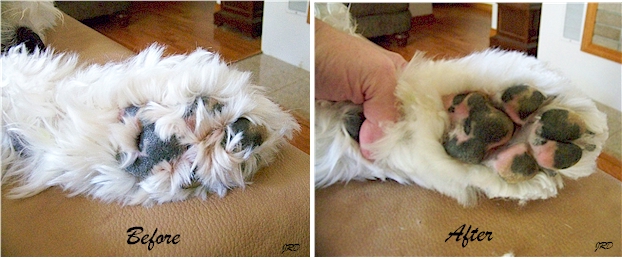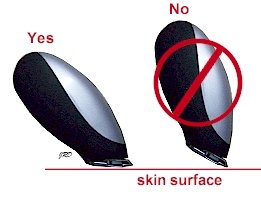 |


Home Grooming The Companion Old
English Sheepdog
Trimming
Around An Old
English Sheepdog's Foot Pads
|
|

What you're trying to accomplish...

Trimming hair between the
Old English Sheepdog's pads improves traction, prevents
painful matting and also allows for better air flow.
Less hair to carry in sand/dirt from the backyard too.
Dogs sweat through their foot pads so removing this hair
helps their feet dry faster too. Hairy feet can hold
dirt, moisture, bacteria,
yeast, etc.
|

Tools I Use To Trim
A Dog's Pad/Foot Hair
You
don't need fancy or expensive tools for this job. I use a small,
inexpensive battery operated palm clipper by Conairpet™ to shave the
hair from between my Old English Sheepdogs pads.
It’s now yellow & black. It's small so it's easy to get
between the pads. I found that rechargeable batteries provide more
power for a longer duration. I like the shorter version of
The Untangler® for the feet but you can use any good comb. I
also use small scissors with stainless steel blades found at the
grocery store… any scissors that cut hair well are fine. Once you
get used to scissoring, you’ll enjoy better quality scissors. |
Palm Clipper Tips
-
Glide the clipper blade over
the skin, don't apply much pressure or you could cause razor
burn.
-
Keep the blade level with the
skin as you shave so you don't cut skin. Use extra care
when there are narrow or raised areas of skin like the top of
the webbing.


-
The little battery operated
palm clipper I used in this demo doesn't heat up like a standard
size clipper. If using a larger clipper and say a #15
blade, frequently touch the blade with YOUR fingers to be
certain the blade isn't heating up... hot clipper blades will
cause your dog pain and possibly a burn. I no longer use a
spray blade coolant... it seemed to clog up and bog down my
blades. I remove a blade that's gotten too warm, place in
on a cool surface and replace it with another blade. I've
also used a cold pack, the kind you keep in the freezer for a
sprain, and will place a too warm blade between it for faster
cooling. You need to be careful of condensation though...
keep the blade dry and oil it after use.
|
Before
trimming an OES's feet for the first time,
get to know how the dog's feet were created. Each foot
has a large pad in the back and 4 smaller toe pads to the front.
Front legs also have a pad on the back of the leg where it
bends at the "wrist". OESs that have not had dewclaws
removed in the first few days after birth will also a small toe
with a pad, webbing and toenail on the inside of the front
legs... you may occasionally find back dewclaws also.

Webbing between the toes. |
 |
 |
The following
technique is based on a dog that is already used
to both having their feet handled and the vibration of
electric clippers...
When using electric
clippers or scissors to trim our dog's feet, I'm very care
that I don't accidentally nick or cut the dog.
Especially important in the foot area is the webbing between
each toe... this webbing is a ridge of skin that separates
the area between the toes from the area around the larger
pad. I like to clip the hair short but I don't apply much
pressure doing so... I don't want to cause razor burn.
Some dogs may be more sensitive to shaving... if this is the
case, you may wish to use a clipper blade that will leave
the hair a little longer. My 5 OESs and Border
Collie-mix all have their feet tended to in this manner.




|

Above is a little neater
example of trimming hair around the outside of the feet. NOTE that
the length you cut the hair depends
on the overall hair length on the dog. If the OESs hair is
longer, you'll need to trim farther way from the outside of the
pads.
|

Finally, I scissor around the outside
of the feet as the dog stands being careful not to
cut the pads.
Visit this page to see one way to round up foot hair. Inspect the finished
feet for any
accidental nicks because it can happen. I wash the feet and
apply a little
antibacterial salve if one is found... then check the
next day to be sure it's healing.
Copyright 2010-13 J.
Dunne. All rights reserved. The photographs and
instructions on this page are the property of the author. This
website page address and the
PDF formatted version can be shared publicly. However, do
not
reproduce, copy or alter it for public or for-profit use without written permission from the author.
|
 |






